
Today is the birthday of Balthas Jetter (December 17, 1851-May 9, 1915). He was born in Engstlatt, Zollernalbkreis, Baden-Württemberg, Germany, but moved with his family to Omaha, Nebraska when he was nine, in 1860. In 1887, he and a partner founded the Jetter & Young Brewery in South Omaha. In 1890, Jetter bought out Young, the brewery was renamed B. Jetter, although it also traded under the name South Omaha Brewing Co. In 1902, it became the Jetter Brewing Co., which it remained until prohibition. It reopened in 1933 and remained in business util 1994, when it closed for good.
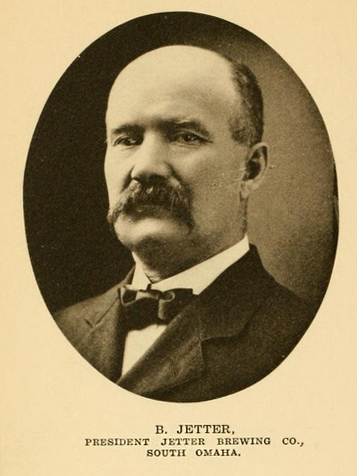
Balthas Jetter, founder of the Jetter Brewing company of South Omaha, died Sunday at 11:20 o’clock from a paralytic stroke sustained Saturday morning.
Mr. Jetter was 64 years of age. He was in his usual good health up to Saturday, when he sustained a stroke. He was found Saturday forenoon in a semi-conscious condition in the brew house by William Hoffman, son of an employee. Physicians were summoned and the stricken man was removed to his home on South Thirtieth street, but he never regained consciousness.
Mr. Jetter is survived by his wife, one son, Henry, and three daughters, Misses Alma, Hulda and Edith Jetter, of this city. Martin Jetter, head of the Jetter Brewing company, is a nephew.
Balthas Jetter was born in Engsclat, Germany, December 17, 1851. He came to the United States in 1871 and was employed on the Union Pacific railroad as a bridge builder. He helped build the Union Pacific bridge at Omaha.
In 1873 he entered into the brewing business in Omaha, where he continued as an employee until 1887, when he removed to South Omaha and launched out for himself on a plat of land now covered by the Armour packing plant. He gradually increased his business until May, 1914, when he retired in favor of his nephew, Martin Jetter, present head of the Jetter Brewing Company. From the penury of a raw immigrant he gradually accumulated a large fortune.
Balthas Jetter was married in Omaha July 7, 1878. His family consists of his wife and four children. One son, Henry Jetter, is interested in the brewing company.
When Balthas Jetter determined to retire from active business a few years ago he made a tour of Germany in company with Fred Drew, vice president of the Jetter company, in order to study the manufacture of German beer. Even after his retirement as active head he continued to manifest interest in the affairs of the company.
His wealth never changed him and his friends say that he lived as simply in his old age as in the days of his early struggle. He was friendly and companionable with his family and friends, but cared nothing for society.
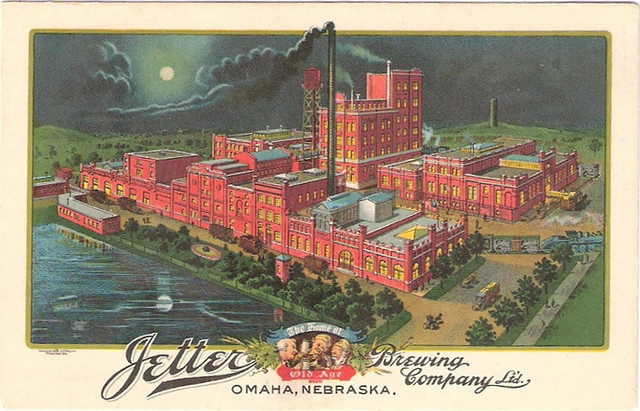
Here’s a short history of the Jetter Brewery from “Nebraska Beer: Great Plains History by the Pint,” by Tyler A. Thomas:
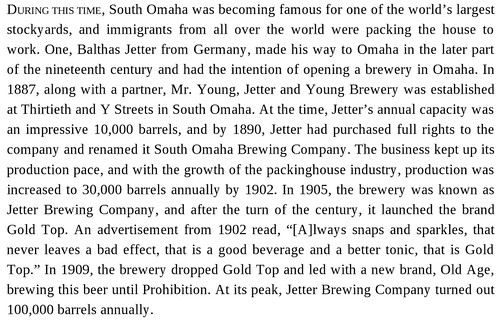
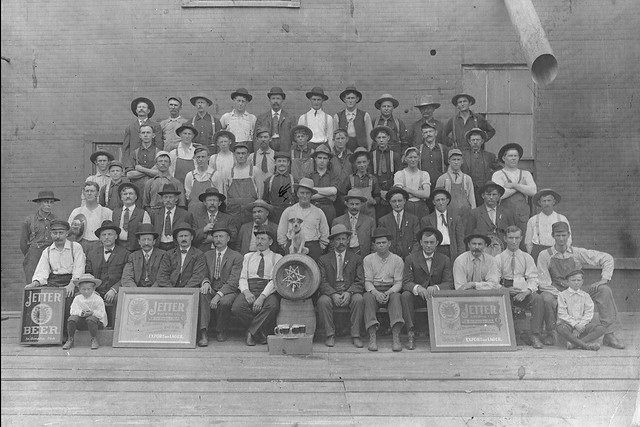
An undated photo of the Jetter brewery employees. I can’t be sure, but it looks like Balthas may be in the top row, fifth from the left.
Here’s a lengthier history of the brewery from Jetter Brewing Company website, which seems to suggest the beer may be making a comeback, and began planning last year:
South Omaha, for many years, has been famous for being the home to one of the nation’s largest stockyards. Along with the stockyards were many very large packing houses. Wilson, Hammond Bros., Swift, Armour & Cudahy were the big five. In their heyday they employed thousands of immigrants from Germany, Poland, Czechoslovakia, Lithuania and many other Middle and Eastern European countries. Immigrants who had settled in Omaha to find their dreams in America. One such immigrant was a German by the name of Balthas Jetter. Jetter found his way to Omaha in the later part of the nineteenth century with the full intention of establishing a brewery to help quench the thirsts of those packing house workers.
In 1887 along with a partner, Mr. Young, Jetter established the Jetter and Young Brewery at 30th & “Y” streets in the heart of South Omaha. Annual capacity at the time was an impressive 10,000 barrels. By 1890 Jetter had purchased his partner’s stake in the brewery and had taken on the name South Omaha Brewing Co., B. Jetter prop. An advertisement in the 1890 Omaha city directory shows an artist’s rendition of the brewery, with the Jetter home in the foreground, the large brewing operation in the center and a small lake to the south. The lake was on land that is now known as Upland Park.
Production at the brewery continued to keep pace with the bustling community of South Omaha. The packing house industry was booming and the Jetter Brewing Company kept pace by increasing their production to 30,000 barrels annually by 1902.
In 1905 the brewery became more simply known as the Jetter Brewing Company. During those years after the turn of the century, Jetter’s flagship brand was “Gold Top”. An ad from 1902 touts Gold Top as a beer that “…always snaps and sparkles, that never leaves a bad effect, that is a good beverage and a better tonic, that is Gold Top”.
Jetter’s, as well as the other Omaha breweries, prospered during the early part of the century. Expansion and modernization of the brewery continued. The brewery was now an all brick, concrete and steel structure.
Sometime around 1909, the brewery dropped the Gold Top brand in favor of the brand name “Old Age”. The Old Age label featured three elderly gentlemen conversing while hoisting steins of Old Age beer. A loaf of bread adorns the table the three are sitting around. Those three gentlemen became well known to beer drinkers. The three adorned every bottle of Old Age and appeared on nearly all pieces of advertising used by the brewery.
The Jetter Brewery continued to produce Old Age beer all the way up to Prohibition. At the height of production, the brewery turned out in excess of 100,000 barrels annually. In 1919 when the production of real beer became illegal, the brewery was forced to halt the brewing of Old Age. Jetter’s turned to the production of soda pop and near beer. Soda pop went under the label “Sahara” and featured a scene right out of the desert. Near beer was marketed under the Old Age name as well as St. Regis brew. Production continued well into the twenties, but with prohibition dragging on the brewery was very underutilized and only maintained a skeleton crew of employees. By 1930 the brewery had ended the production of any type of beer or soda. The brewery sat idle for the first time in 43 years.
You can pick up their more recent story at the history page.
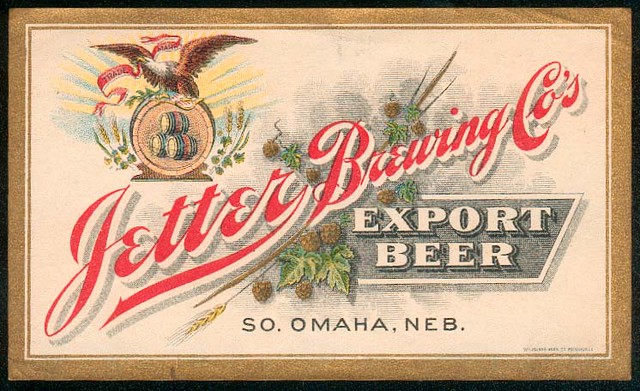
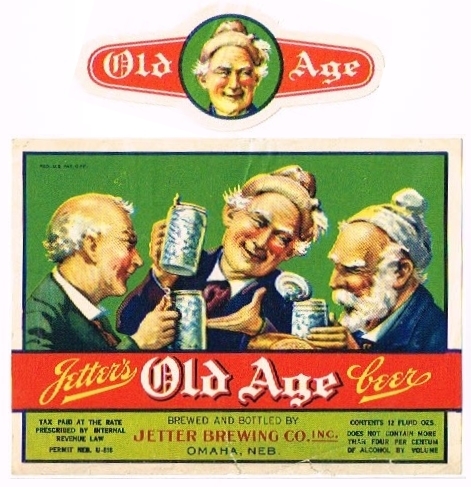
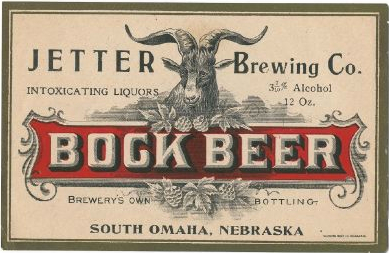

Thanks for the great write-up, Jay! Awesome!